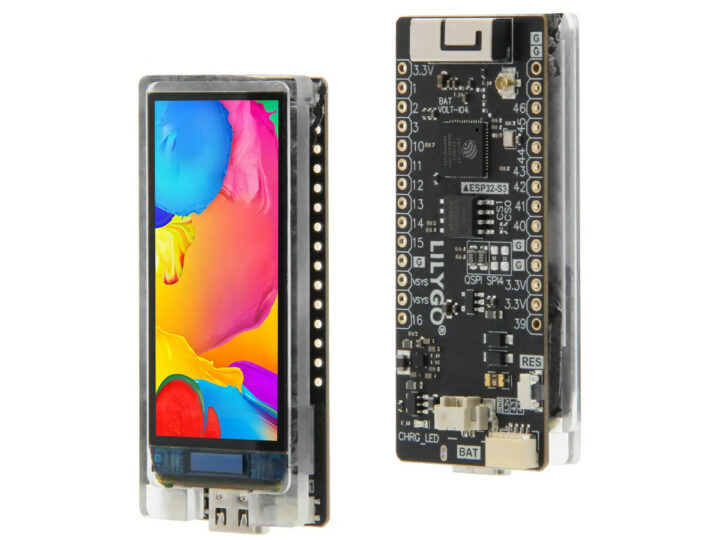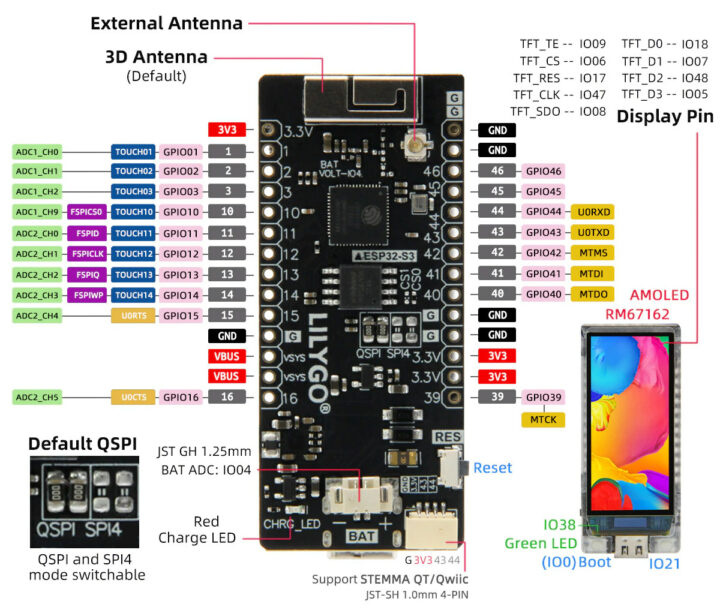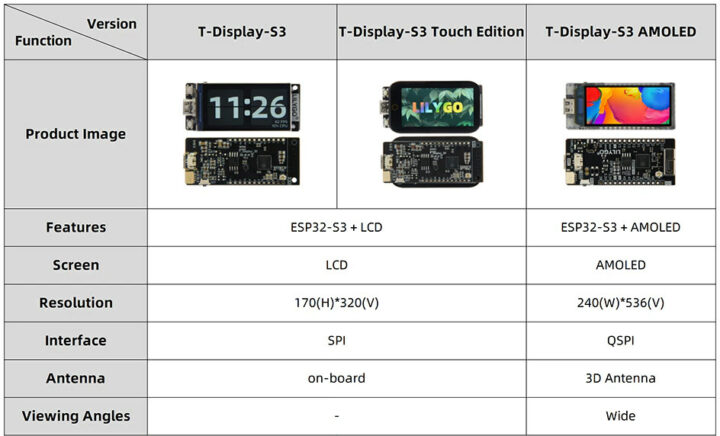There are plenty of ESP32 series boards with display usually TFT or E-Ink, but I don’t think I’ve ever seen one with an AMOLED display and that’s what Lilygo is offering with the “T-Display-S3 AMOLED” board equipped with an ESP32-S3 WiFi and Bluetooth microcontroller and a 1.9-inch AMOLED display.
The new board is almost the same as the T-Display-S3 board introduced last year, except for a display with higher resolution, more vibrant colors, and a wider viewing angle, plus a 3D antenna, and a few extra I/Os.
T-Display-S3 AMOLED specifications:
- Wireless MCU – Espressif Systems ESP32-S3R8 dual-core Tensilica LX7 @ up to 240 MHz with vector instructions for AI acceleration, 512KB RAM, 8MB PSRAM, wireless connectivity
- Storage – 16MB flash
- Connectivity via ESP32-S3
- 2.4 GHz 802.11 b/g/n Wi-Fi 4 with 40 MHz bandwidth support
- Bluetooth Low Energy (BLE) 5.0 connectivity with long-range support, up to 2Mbps data rate.
- 3D antenna and external u.FL antenna support
- Display – 1.9-inch 536×240 AMOLED display with RM67162 QSPI or SPI display controller
- USB – 1x USB Type-C port for power and programming
- Expansion
- 2x 14-pin headers with up to 18x GPIO, 1x SPI, 10x ADC, SPI, UART, Touch interfaces, 5V, 3.3V, and GND
- 4-pin STEMMA QT/Qwiic connector with 3.3V, GND, and 2x GPIOs (IO43, IO44)
- Misc – Reset, Boot, and User (IO21) buttons; red charging LED, green user LED (IO38)
- Power Supply
- 5V via USB Type-C port
- 2-pin 1.25mm pitch JST header for LiPo battery
- Dimensions – 60 x 25.5 x 10mm
The SPI (CS, MOSI, SCLK, DC) or QSPI (CS, SCLK, D0, D1, D2, D3) mode is selected with some zero Ohm resistors that you need to solder. Driving the display through QSPI can quadruple the speed compared to SPI, and I can’t see any downside because D0-D3 pins don’t seem to be multiplexed with the GPIO headers. You’ll find the schematics, datasheets, and basic instructions to get started with the Arduino IDE, PlatformIO, or the ESP-IDF on GitHub with the only sample being the factory test code.
Lilygo boards may not be recommended to beginners or occasional hobbyists as I can often see comments saying the sample code does not work, and people are unclear on how to get started. As mentioned in the introduction, the T-Display-S3 AMOLED is very similar to the T-Display-S3 and T-Display-S3 Touch with the main differences shown in the table below.
Liligo is selling their ESP32-S3 AMOLED board on Aliexpress for $33.98, which compares to $19.98 for the original T-Display-S3, and $26.95 for the Touch model. If you’re not a fan of Aliexpress, the new board should eventually show up on the company’s Amazon store as well.

Jean-Luc started CNX Software in 2010 as a part-time endeavor, before quitting his job as a software engineering manager, and starting to write daily news, and reviews full time later in 2011.
Support CNX Software! Donate via cryptocurrencies, become a Patron on Patreon, or purchase goods on Amazon or Aliexpress







